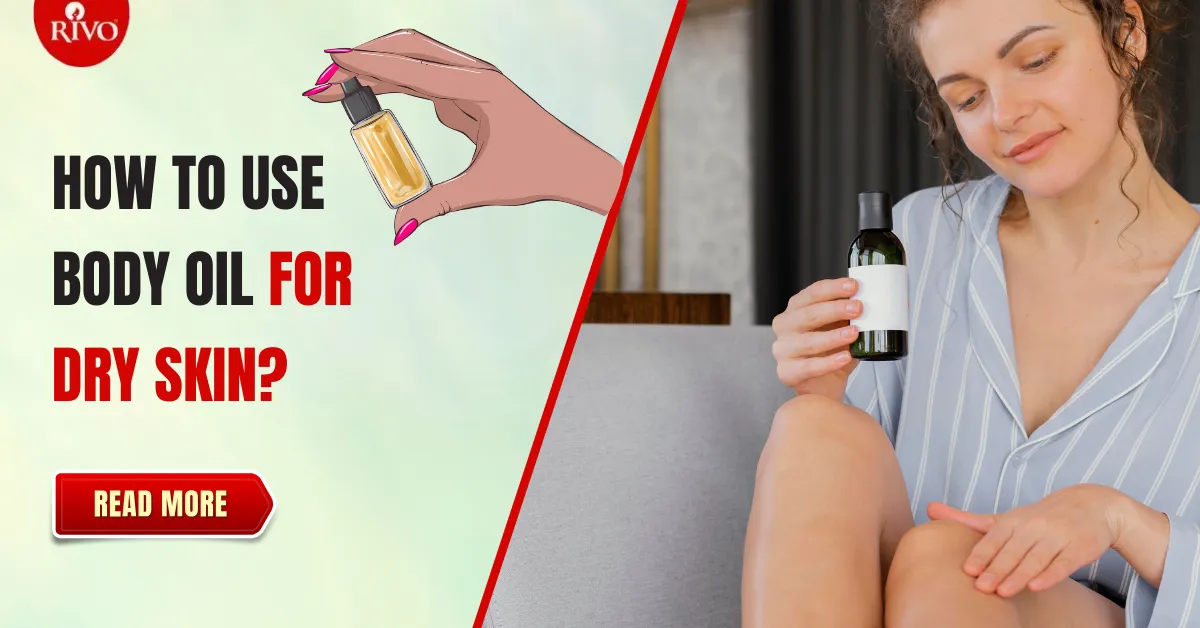Years ago dry, flaky, or tight-feeling skin could be written off as a temporary inconvenience that comes in season; but now it is an indication that your skin barrier is requiring some assistance. At Rivo Skin Clinic, we often recommend adding body oil for dry skin as a nurturing step in your skincare routine. The way you use it, when you apply it and which ingredients are important are all factors that influence how effective it will be.
In this blog, we’ll explore how to use body oil for dry skin, its benefits, myths, precautions, and expert-approved application methods. How about we make your skin glow with softness, healthy and hydrated?
What Is Body Oil?
Body oil is a light oil made as skincare substance to moisturize the skin thoroughly and trap moisture inside along with enhancing the elasticity of the skin. It resembles our skin oils that are naturally produced and it is therefore particularly successful in cases where people have dry skin problem.
Body oils are occlusive, i.e., they create a protective barrier, unlike lotions or creams, which allow water evaporation. That’s why dermatologists and aesthetic experts at Rivo often recommend body oil for dry skin for lasting hydration.
Benefits of Using Body Oil for Dry Skin
Here are the top benefits of incorporating body oil for dry skin into your daily routine:
- Deep Moisture Retention: Eliminates trans epidermal water loss making your skin soft and supple.
- Better Skin Barrier: Heals and reinforces the protective surface of the skin.
- Calming & Anti-inflammatory: It reduces itchiness, irritation and redness.
- Natural Glow: Gives you a good, dewy appearance without its turning greasy on your skin.
- Skin Health in the long run: Prevents flakiness, dullness as a result of severe dryness.
Understanding Your Skin’s Absorption Capacity
It is essential to evaluate the absorption status of your skin before using any oil on it. It is not a one size fits all process, some people have a lipid deprived barrier that gobbles up oil and some people with combination or keratinized skin can have oil sitting on their surface and leave them with the greasy or clogged feeling.
At Rivo Skin Clinic, we educate patients about their skin’s barrier function and trans epidermal water loss (TEWL). Compromised barriers usually have characteristics such as dullness, flakiness, tightness and itchiness, all of which means that richer, occlusive-based care needs to be provided.
How to determine your absorption rate:
- Put 2-3 drops of oil on your forearm when you are showering.
- Wait 10 and note:
- In case it is completely absorbed then your skin is probably dry or deficient in lipids.
- When it remains shiny or sticky, you should consider going down in terms of selecting lighter oils or oil blends.
- When it itches or turns red => you might require a hypoallergenic product or patch assessing.
When you know how your skin gets along with oils, you understand what kind of texture and composition you should choose: whether it is the cold-pressed and fast-absorbing dry oil, or the richer versions based on emollients.
When Should You Apply Body Oil?
Timing matters. Apply body oil for dry skin within 2–3 minutes after showering—while your skin is still damp. This also assists in locking up as much moisture as possible and the oil is not difficult to absorb.
Recommended Times:
Morning: Drink to seal in that water. Make use of lighter oils such as jojoba or grapeseed.
Night: Apply more oil (such as almond or avocado) to repair and replenish in the night.
How to Use Body Oil for Dry Skin – Step-by-Step Guide
Use the following steps recommended by experts:
- Cleanse Gently
Take a gentle, unscented body wash. Don not use harsh soaps which take away the natural oil.
- Pat Skin Dry, Don Not Rub
Slightly wet your skin after taking a shower.
- Heat the Oil
Put a drop or two in the palms of your hands and rub them together just enough to warm up the oil.
- Massage Gently
Rub in upwards, circular movements. Target the dry prone skin areas such as the elbows, knees, and heels.
- Put in a Layer as Needed
For extra hydration, apply a light moisturizer first, then seal it with body oil for dry skin.
- Let It Sink In
Then wait at least several minutes to put on other clothes so as not to spill oil on clothes.
Choosing the Right Body Oil for Dry Skin
All body oils are not created equal. Here’s how to choose the right one:
Oil Type | Best For | Why It Works |
Coconut Oil | Severely dry or cracked skin | Rich in fatty acids; anti-fungal |
Almond Oil | Sensitive or inflamed skin | Vitamin E; calming properties |
Jojoba Oil | All skin types | Mimics natural sebum |
Argan Oil | Aging skin with dryness | Antioxidants + Omega-6 |
Rosehip Oil | Dull, flaky skin | Rich in Vitamin C; brightening effect |
Always choose cold-pressed, organic oils and consult with a skin expert at Rivo if you’re unsure.
Common Mistakes to Avoid
Even the best body oil for dry skin can be ineffective if misused. It is best to avoid the following pitfalls:
- Applying on completely dry skin (it won’t absorb well)
- Applying excessively-a little goes a long way
- Omitting patch testing- This is because there may be some natural oils that can be of irritation to the sensitive skin
- Applying perfume or essential oils mixtures without consulting the professional
- Oil as a substitute to moisturizer– it is a supplement, not a replacement to moisture
Seasonal Considerations for Dry Skin
During winter, your skin should be richer oils. During summer, use non comedogenic, light ones. Remember, body oil for dry skin works best when it’s tailored to the climate you live in—especially in humid places like Mumbai.
Can You Mix Body Oil with Other Products?
Yes! Here’s how:
- With Lotion: Add a few drops to your favourite body lotion to help it go further as a hydrating agent.
- With Body Scrub: Add to sugars or coffee scrubs as a mild exfoliation and nourishment.
Bath Water: A couple drops of the warmed water, produces a spa like treatment of hydrating the toner
Why Choose Rivo Skin Clinic for Dry Skin Solutions?
Rivo Skin Clinic knows how immovable dry skin can feel. In our approach we have:
- Custom skin consultation
- Body oils recommended by the dermatologist
- Medical grade hydration treatment
- After-treatment skincare advice
Combining clinical solutions with the right body oil for dry skin, we help you treat the cause—not just the symptoms.
Real Case Study from Rivo
Our patient (aged 36 years) was a working woman who had a problem of constantly having dry patches on her legs and arms. After switching to dermatologist-approved body oil for dry skin post-shower and undergoing weekly hydrating facials at Rivo, she saw over 80% improvement within 4 weeks.
FAQs on Body Oil for Dry Skin
While it significantly improves hydration and texture, chronic dry skin may also need internal support (diet, water intake) and professional treatments.
No. For best results, use lotion first and seal it with body oil for dry skin. It is more effective as moisture lock.
Yes, but be selective with the oils you use; use mild ones such as almond or jojoba and always test it on a patch. Talk to Rivo gurus on advice according to age.
After one week of regular usage, most people report softer and more hydrated skin.
It must be non-comedogenic oil that suits the facial skin. Ask a dermatologist before applying any body oil for dry skin to the face.
Use once a day after a shower but dry skin can be used twice daily.
Call us - Rivo Skin Clinic
Are you ready to change your skin?
Contact your Rivo Skin Clinic today and book your consultation to get personalized solutions to dry skin, advanced treatment and guidance on FDA approved products.
Rivo Skin Clinic, Mumbai and Navi Mumbai






